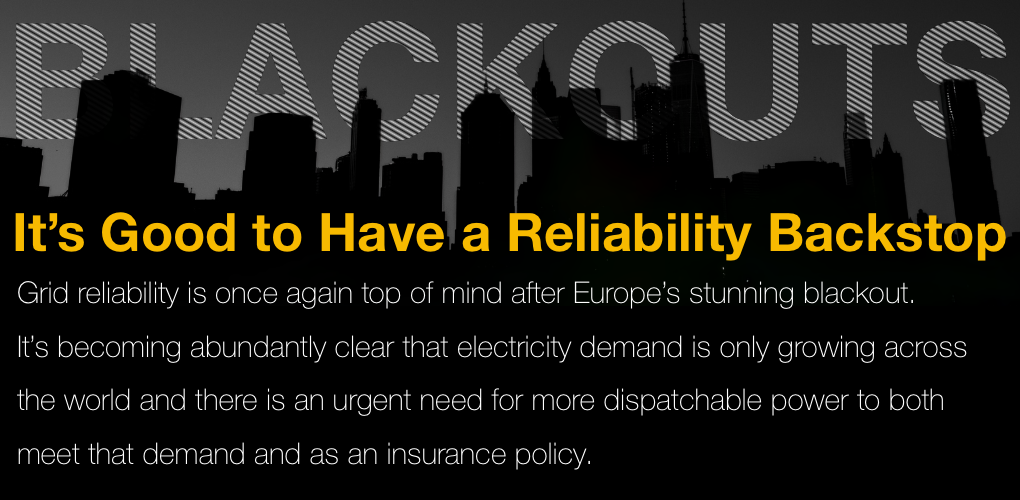
It’s Good to Have a Reliability Backstop
With Spain, Portugal and parts of France still reeling from a stunning blackout, grid reliability is once again top of mind. While it remains to be seen what caused the grid failure, the complexities of moving away from dispatchable power and towards heavy reliance on intermittent energy are understandably in the spotlight.
Regardless of what is determined to be the ultimate cause in this instance, what is becoming abundantly clear on both sides of the Atlantic is that electricity demand is only growing, and there is a need for more dispatchable power to both meet that demand and as an insurance policy for the inherit unpredictability of weather-dependent generation. That’s indeed the case in Germany with its ongoing struggles with the dark doldrums, or “dunkleflaute.”
As the Wall Street Journal recently observed, Germany continues to invest hundreds of billions of euros into wind and solar power but its share of electricity from renewables has actually fallen during the first quarter of this year by a significant margin. Renewable sources accounted for some 47% of electricity consumption in Germany in the first three months of 2025. That’s down from 56% in the first three months of 2024.
Despite adding 872 wind turbines with a capacity of 4.3 gigawatts since April of 2024, wind generation in Germany fell by 16%. This months-long drop in the potency of renewable power due to uncooperative weather is a feature of renewable power systems, not a bug. And alarmingly, days or weeks when renewable generation is all but a no-show is also a feature grid planners and policymakers can no longer ignore. Germany is once again rethinking the timeline for closing its coal fleet and weighing adding 20 GW of new natural gas generation.
The Case for Balance
A balanced mix of resources is critically important to navigating the uncertainty of this energy moment. With power demand soaring and questions about the reliability of intermittent generation only growing, the need to preserve already available, fuel-secure dispatchable power is plainly obvious.
Keeping the coal fleet as a backstop for the U.S. grid is responsible energy policy. Doing so not only addresses mounting reliability concerns but provides essential dispatchable fuel diversity to temper inflationary pressure on consumers from natural gas price volatility and a U.S. gas market increasingly connected to global demand.
Consider the importance of the U.S. coal fleet this year. With rising power demand and colder weather this February, coal generation across the U.S. jumped 41%, according to the U.S. Energy Information Administration. This was the third straight month coal power eclipsed year-earlier levels. Preliminary data from both PJM and MISO for March show continuing rises in coal demand from a year earlier, up 38% and 34% respectively.
The Trump administration has rightfully zeroed in on the ongoing importance of the coal fleet and the critical role it must play in meeting the soaring new power demand at our doorstep.
One of the staggering challenges now facing the electricity sector is the inability to add new generation in a timely and cost-effective manner. Facing risings costs and ongoing supply chain challenges, about 28% of planned wind, solar and battery projects have been delayed or canceled, according to recent reporting from The Wall Street Journal. And efforts to build natural-gas-fired power plants are facing similar challenges with wait times for turbines stretching three years and the cost to build new gas generation tripling in less than a decade.
With U.S. competitiveness and ongoing efforts to fight inflation hanging in the balance, the importance of existing, well operating and underutilized generating capacity is paramount. The coal fleet is already an essential bulwark of the U.S. power system but it’s ability to fill the rapidly emerging gaps between the power we have and the power we need in the years ahead is an emerging story worth watching.
- On April 30, 2025
